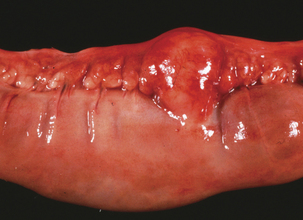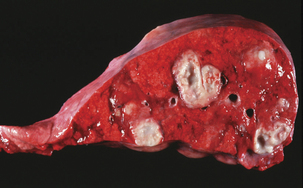Chapter 12 The Genus Rhodococcus
The genus Rhodococcus is part of a distinctive actinomycete taxonomic group that includes the genera Corynebacterium, Mycobacterium, and Nocardia. This taxonomic group is defined by the presence of unique lipid-rich cell envelope structures rich in mycolic acids that promote intramacrophage survival and granuloma formation. The only pathogenic Rhodococcus is Rhodococcus equi, a cause of granulomatous pneumonia in foals and immunosuppressed humans.
Disease and Epidemiology
The simple growth requirements of R. equi are provided by nutrients in herbivore manure and high environmental temperatures. Sandy acid soils in paddocks continually used for breeding mares are likely sites for infection of foals, which inhale the organism with blowing dust. The resulting disease is a pyogranulomatous bronchopneu-monia (Figure 12-1), with cranioventral abscesses a reflection of inhalation of organisms. Swallowing of infected sputum gives rise to ulcerative colitis and mesenteric lymphadenitis (Figure 12-2), with diarrhea. Hematogenous dissemination may result in osteomyelitis in long bones or vertebrae. Affected foals are typically about 6 weeks of age, but age at onset ranges from 1 to 6 months.

FIGURE 12-2 Chronic suppurative colitis in a 3-month-old Thoroughbred foal.
(Courtesy M. Kevin Keel.)
Infection by R. equi is frequently isolated from immunosuppressed humans, particularly from cases of pyogranulomatous pneumonia in patients with acquired immunodeficiency syndrome (AIDS). If isolates from patients with AIDS have the virulence plasmid, it is usually of the porcine type, although a small proportion possess the foal type. Thus R. equi probably has little zoonotic significance.
Stay updated, free articles. Join our Telegram channel

Full access? Get Clinical Tree



